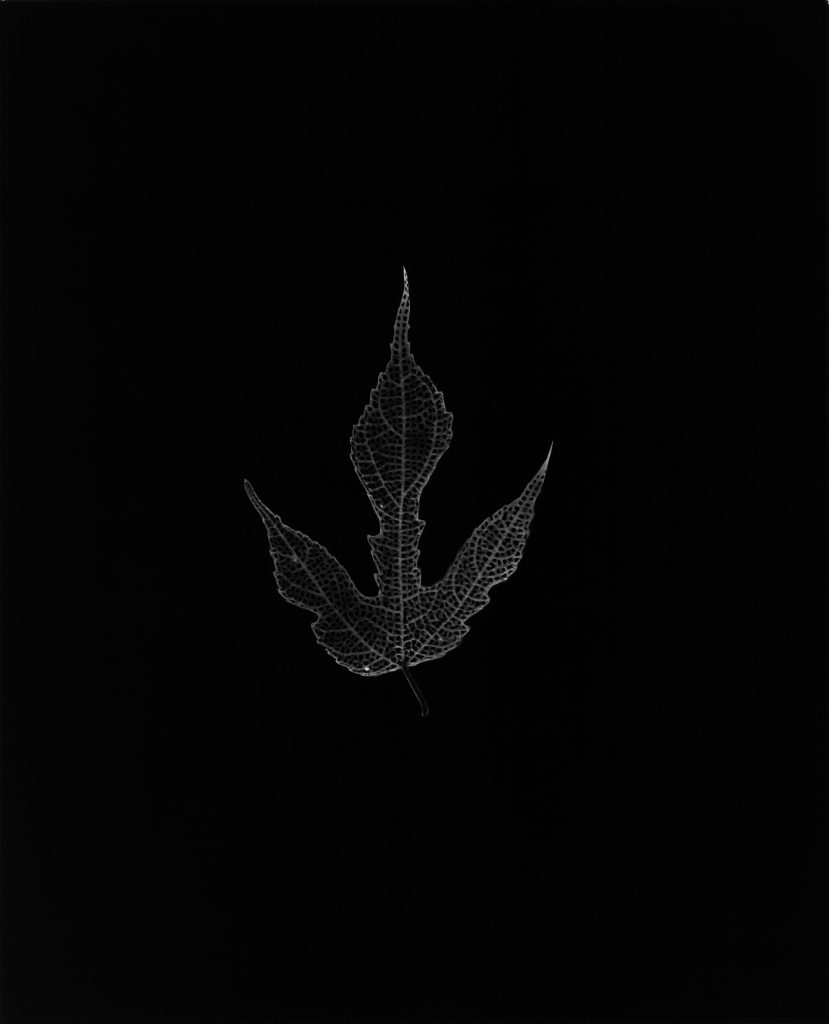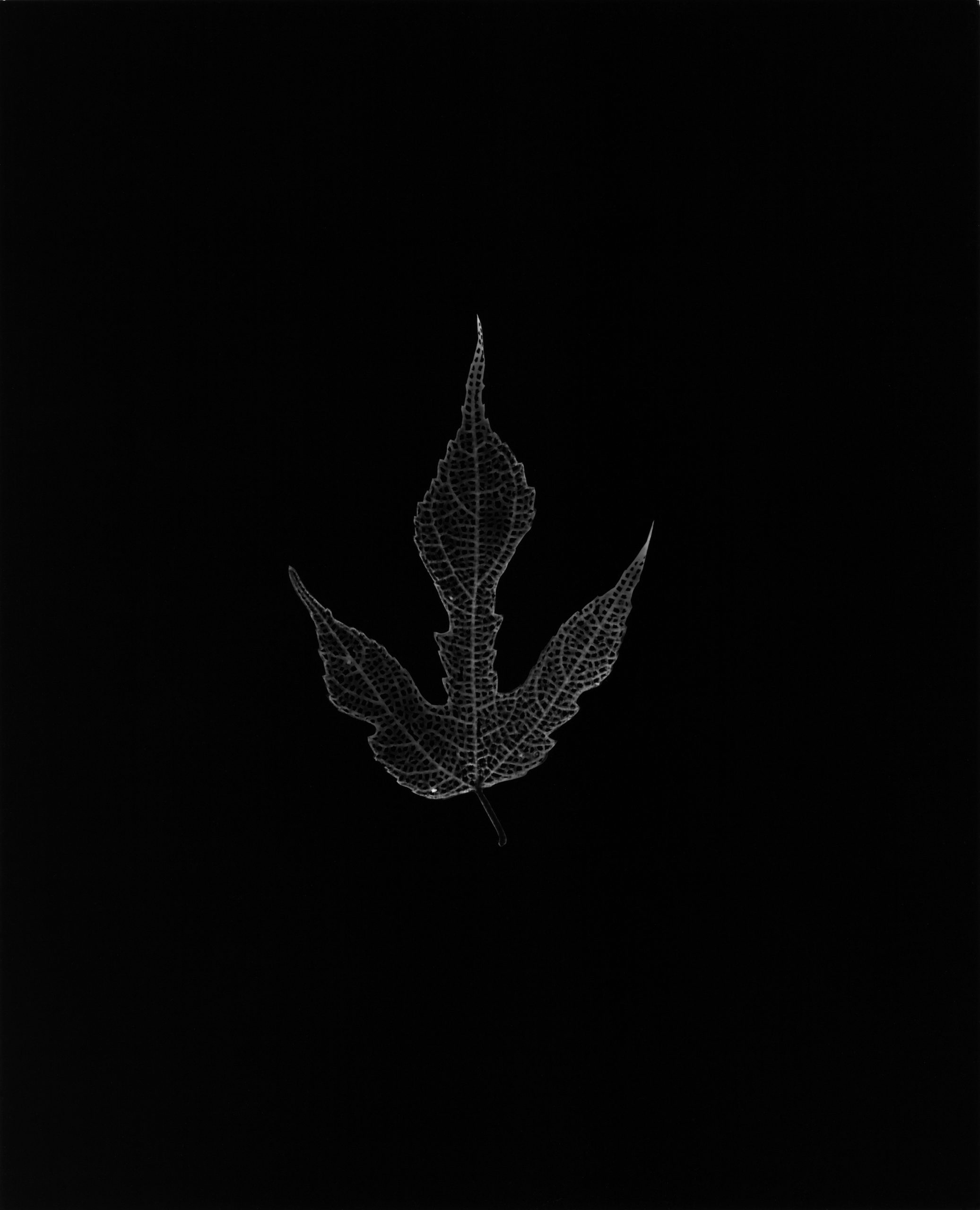
monade contemporary|単子現代
会期:2023年8月26日(土)~9月17日(日)|金・土・日 14~19時
*レセプション:8月26日(土)18時~、トークイベント:9月9日(土)19時~
〈ステートメント〉
一枚の紙を彫り形象を表す切り絵と、にじみやぼかしによる表現の間には距離がある。刃物による切り口は鋭く、紙が残された部分と切り抜かれた穴、有と無の境界に曖昧さがないから。しかし、切り絵がにじみやぼかしを生み出せないわけではない。切り絵に光を当てると影が落ちる。光源によってその輪郭はくっきりしたり、ぼんやり見えたりする。揺らぐ影には奥行きと動きがあって美しい。境界はにじむ。
影そのものは実体がないが、それを紙に焼き付ける方法がある。印画紙の上にものを置き、感光させるフォトグラムである。薄く容易に切り抜ける紙は、型紙として主に工芸品の制作工程で多用されてきた。今回自分が行ったことも切り絵を型にして光を紙に染めつけており、意図せず、歴史的に連綿と行われてきたことと重なっている。素材の特性に導かれ制作をしていることにあらためて気がつく。
正倉院には千数百年前の吹絵紙が残る。楮紙の上に型を置き、絵の具を蒔き付けて装飾した素朴で美しい料紙だ。型はおそらく現存しないが、その存在と制作を手掛けた人間の息遣いが伝わってくる。自身の作品も、切り絵ではなくこのフォトグラムが残るかもしれない。わからない。わからないけれど、ひとつ新たな種を撒いたと感じている。
出来上がったフォトグラム作品には、肉眼では視認できない切り絵の紙の繊維が写し出された。技術が浮かび上がらせるリアルが身体による認識を広げ、一枚の紙に奥行きを見る眼を加えた。
― 望月めぐみ
〈展覧会情報〉
monade contemporary | 単子現代では、アーティスト 望月めぐみによるPCPG(papercutting photogram)を開催します。
望月はこれまで、日本に古来伝わる龍や菊、あるいは人魚姫といったおとぎ話に見られる存在をモチーフとして切り絵作品を制作するなかで、時間を超えた出合いや交わりに目を向けてきました。また最近では、無数の幾何学的なパターンのなかから伝説や宗教的なイメージが出現する大作も展開しつつあります。人あるいは風の気配のなかで揺れる紙の形象は、幾重にも折り重なる光と影の彫刻となって荘厳に輝きをまとうかのようです。
近年、望月は切り絵の気配を構成するにじみやぼかしなどの表現に着目し、感光紙にものを置いて撮影するフォトグラムという写真技法に親しんできました。本展では、望月にとってはじめての試みとなるフォトグラムと切り絵を合わせたPCPG(papercutting photogram)という独自の技法によって制作された作品群を紹介します。和紙というメディアそのものを彫刻し形象を出現させる切り絵という技法が、ものを感光さることによって描画する写真の技法と出合うとき、光と影はどのように交わり、かたちとなるのでしょうか。和紙の原料となる楮、花鳥風月や霊獣、あるいは日本を象徴する菊といったモチーフとともに立ち現れる、イメージ-形象の創生にご参加ください。
〈アーティスト〉
望月めぐみ
紙をナイフで刻み生まれるシャープでなめらかな曲線と、透ける造形美を追求する。数メートルに及ぶ一枚紙を手作業で刻んだ大型作品も制作。作品を通し、人間の手の持つ可能性を伝える。主なモチーフは神話、古典文学など。伝統文化とのコラボレーション多数。近年の活動に、個展「祈り咲く空」(富士川・切り絵の森美術館、山梨、2023)、Schweizerische Scherenschnitt Ausstellung、Hans Erni Museum、Switzerland、2022)、個展「交 CROSS」(祇をん小西、京都、2021)などがある。
https://www.mochime.com/
Megumi Mochizuki Exhibition PCPG
monade contemporary|単子現代
Dates: August 26 (Sat) – September 17 (Sun), 2023|Friday, Saturday, Sunday 14:00 – 19:00
*Reception: August 26 (Sat), 18:00 -, Talk Event: September 8 (Sat), 19:00 –
〈Statement〉
There is a distance between paper-cutting, in which a single sheet of paper is engraved to express a figure, and expression through nijimi (blurring) and bokashi (feathering). The cut by the blade is sharp, and there is no ambiguity in the boundary between the part of the paper that remains and the hole that has been cut out, between existence and nothingness. However, this does not mean that kirie (paper-cutting) cannot produce blurring and feathering. When light shines on a cutout, shadows fall. Depending on the light source, the outlines of the shadows may appear clear or blurred. The shimmering shadows are beautiful because they have depth and movement. Boundaries are blurred.
Shadows themselves are insubstantial, but there are ways to burn them onto paper. It is a photogram, in which an object is placed on a piece of photographic paper and made to become light-sensitive. Paper, which is thin and easy to cut through, has been widely used as a paper pattern mainly in the production process of crafts. What I have done this time is to dye light onto paper using paper-cutting as a pattern, which is unintentional and overlaps with what has been done historically. Once again, I realize that I am guided by the characteristics of the materials.
There is a piece of fukie (a technique to create tints by placing a cut-out pattern on paper) paper from more than 1,000 years ago in Shōsōin. It is a simple and beautiful paper decorated by placing a mold on Kōzō (paper mulberry) paper and sprinkling pigments on it. Although the molds are probably no longer extant, we can feel the presence of the paper and the breath of the people who worked on its creation. It is possible that this photogram, rather than a paper cutout, may remain in my work as well. I don’t know, but I feel that I have planted a new seed.
The resulting photograms show fibers of paper-cutting that cannot be seen with the naked eye. The realism brought to light by the technique broadened the perception of the body and added an eye to see depth in a sheet of paper.
― Megumi Mochizuki
〈Exhibition Information〉
monade contemporary | 単子現代 is grateful to present PCPG (papercutting photogram) by artist Megumi Mochizuki.
Mochizuki’s kirie, paper-cutting has been inspired by the ancient Japanese dragons, chrysanthemums, or fairy tales of mermaids, and her work has focused on the encounter and crossover that transcends the boundaries of time. Recently, she has also been developing large-scale works in which legends and religious images emerge from myriad geometric patterns. The paper figures shimmering in the presence of people or the wind seem to become sculptures of light and shadow folded in layers with magnificent radiance.
In recent years, Mochizuki has been working with photograms, a photographic technique in which an object is placed on light-sensitive paper and photographed, observing the blurring and feathering that make up the appearance of the paper-cutting. The exhibition introduces Mochizuki’s first attempt to integrate photogramming and paper-cutting into her unique technique named PCPG (papercutting photogram). How do light and shadow meet and crossover when the technique of paper-cutting, sculpting the medium of washi (Japanese paper) itself to produce figures, encounters the photographic technique of drawing by sensitizing an object? Please participate in the creation of images/figures that emerge with motifs such as Kōzō (paper mulberry), the raw material of Japanese paper, flowers, birds, wind, and the moon, sacred animals, and chrysanthemums, a symbol of Japan.
〈Artist〉
Megumi Mochizuki
She pursues sharp, smooth curves and translucent beauty of form created by carving paper with a knife. She also has been creating large works of several meters long single sheets of paper, which she engraves by hand. Through her artworks, she communicates the possibilities of the human hand. Her main motifs are mythology, classical literature, etc. She has collaborated with many traditional cultures. In recent years, she has held Prayer Blooms in the Sky (Fujikawa Kirie Art Museum, Yamanashi, Solo, 2023), Schweizerische Scherenschnitt Ausstellung, Hans Erni Museum, Switzerland (2022), CROSS (Gion Konishi, Kyoto, Solo, 2021) among others.
https://www.mochime.com/
